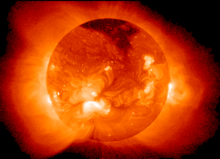Solar research
The solar research focuses on the astronomical, physical and chemical phenomena of the sun . It is one of the fields of science that was already practiced more or less precisely during ancient times.
General
In particular, phenomena such as the solar eclipse still have a lasting impression on the viewer today and lead to natural questions about the nature of the sun.
As early as 450 BC Chr. Describes Heraclides Ponticus a solar system , in which some of the planet , however, the sun revolve around the sun, turn around the Earth. Buildings like the pyramids and Stonehenge suggest even earlier observations of the course of the sun and the stars. The were sunspots already known in antiquity, are in Europe but only after the invention of the telescope was perceived.
For astrophysics , solar physics is of elementary importance, as it shows a typical representative of the fixed stars in relatively close proximity. The results of solar research can be applied to almost all stars in the universe. The preoccupation with the phenomena on the sun led to significant advances in other areas of physics, among others. a. the atomic and nuclear physics , the magneto-hydrodynamics and plasma physics .
The special research area of helioseismology examines the natural vibrations of the sun and gains knowledge about the internal structure of the sun and the processes that take place in it.
equipment
Solar research uses numerous devices that are also adapted to the observation conditions (e.g. the enormous radiation intensity ).
Results
On the results of solar research, see main article sun .
Practical meaning
The practical importance of solar research is related to the effect of the sun on the earth:
- Utilization of the radiation emitted to earth (e.g. in solar collectors ),
- terrestrial radio traffic (interference from solar activity) and
- Disturbances of the earth's magnetic field .
history
For a chronological listing of important events in solar research, see the solar research timetable .
literature
- Otto Kiepenheuer : The sun . Berlin u. a., Springer-Verlag 1982.
Web links
- The sun. On: raumfahrer.net
Videos
- Is the sun special? from the alpha-Centauri television series(approx. 15 minutes). First broadcast on Sep 29 2004.
- Does the sun control our weather? from the alpha-Centauri television series(approx. 15 minutes). First broadcast on Nov 12, 2003.
